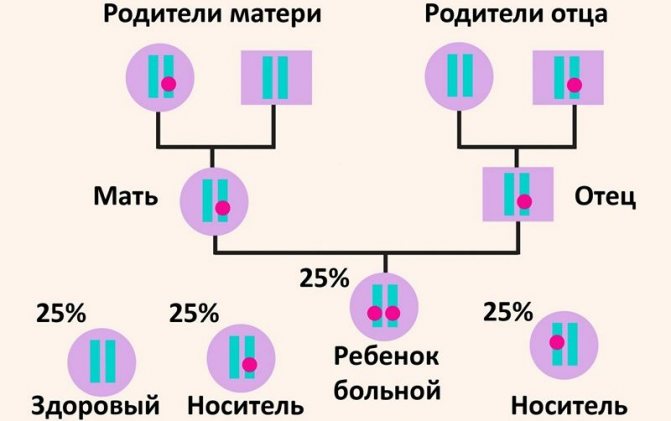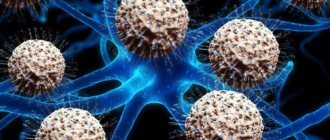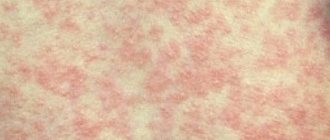Galactosemia is an inherited disease associated with impaired carbohydrate metabolism. It consists of a failure in the breakdown of galactose caused by an enzyme defect. This disease occurs in newborns with a frequency of one in 10–15 thousand babies.
The course of the disease was first described in 1917; its causes were determined forty years later (1956).
The disease is incurable; making this diagnosis entails disability. The timing of detection determines how successful the therapy will be. Delayed detection of galactosemia will lead to death.
Types
Three enzymes take part in the absorption of galactose; the type of disease depends on which one is defective.
There are 3 types of disease:
- Classic (type I) – galactose-1-phosphate-uridyltransferase (GALT) deficiency. The most dangerous form, characterized by rapid progression, accumulation of galactose, and a high probability of death. Accompanied by pronounced symptoms.
- Duarte (type II) – associated with galactokinase (GALA) deficiency. The symptoms are not as bright as with the classic one. Accompanied by the occurrence of cataracts.
- Los Angeles (type III) - diagnosed with a lack of uridine diphosphate-galactose-4-epimerase (GALE), the least common form. In many cases there are no symptoms. When complicated, it is similar to the classic type and can lead to deafness.
Galactosemia in children varies in severity: mild, moderate, severe. The latter poses the greatest danger to the child. Accumulating, galactose causes pathology of the main systems of the body.
Causes of galactosemia in children
The cause of galactasemia in children is a defect in an enzyme called galactose-1-phosphate uridyl transferase, which is necessary to convert galactose into glucose. The gene responsible for the synthesis of this enzyme is located on the second chromosome (pericentromeric region). In the presence of mutations affecting the above locus, one of the variants of the disease occurs. The product of incomplete conversion of galactose, galactose-1-phosphate, accumulates in the blood and has a toxic effect. During the disease, true hypoglycemia is observed, leading to malnutrition and growth retardation in sick children.
The following pathological processes occur during the disease:
- cerebral edema caused by the accumulation of galactose in the ventricles and cerebrospinal fluid;
- liver damage with the development of hypoprothrombinemia, hypoproteinemia;
- an increase in the level of unconjugated bilirubin in the blood;
- anemia associated with the death of red blood cells due to a decrease in their oxygen absorption.
With age, galactose metabolism increases, which may be due to the following factors:
- increased activity of uridine diphosphate galactose pyrophosphorylase;
- testosterone stimulation of galactose-1-phosphate uridyltransferase, which is clearly manifested during puberty in boys.
Recently, variants of the disease that are not accompanied by liver damage have become increasingly common.
How to identify galactosemia in a child |
| Frequent loose stools should alert you |
| the second symptom is excessive regurgitation |
| yellowness of the skin combined with poor sleep |
Causes

Galactose is one of the three most famous monosaccharides, but is not as sweet as sugar . Galactose enters the newborn's body with milk. To assimilate it and convert it into glucose, enzymatic reactions are carried out. The level of activity of enzymatic reactions in patients is 40–50% below normal.
In the absence of the necessary enzymes, galactose accumulates, causing system intoxication and disruption of the functioning of many organs.
The disease is transmitted according to an autosomal recessive inheritance pattern. Disturbed genes are transmitted to a child from both parents - carriers of a dangerous recessive gene.
When the mutant gene is inherited from one of the parents, the child becomes a carrier of galactosemia, but experiences minor symptoms. Research shows that 1 in 250 people are carriers.
The incidence of the disease varies from country to country. For example, in the land of the rising sun this disease is rare. And among gypsy families in Ireland it occurs quite often due to consanguineous marriages.
Galactosemia in a child: causes and consequences

There is something cosmic in the name of the disease, reminiscent of distant galaxies and our little Earth. But there is nothing supernatural about galactosemia: just an unfortunate combination of genes. The disease is genetically determined, which means that galactosemia cannot be cured, and this is bad news. But there is also a good thing: galactosemia is a rare disease, since it is transmitted to a child only if he receives a defective gene from both parents. This happens on average to one baby out of 60 thousand. However, such cases are not isolated. The disease is rare in Japan, but among Irish gypsies this disease is quite common due to frequent consanguineous marriages and the accumulation of defective genes.
Why is galactosemia dangerous? The disease is often confused with lactose intolerance, but this is wrong. The only thing these illnesses have in common is that milk, including mother’s milk, becomes poison for the newborn. This happens because gene disorders cause changes in the process of carbohydrate metabolism.
Normally, lactose in milk is broken down by enzymes into glucose and galactose. Galactose, in turn, is also converted into glucose and is also involved in the construction of cell membranes and cells of the nervous system. But some products of its metabolism are toxic and can accumulate in the body, causing irreparable harm.
With galactosemia, the process of converting galactose into glucose and other substances needed by the body is disrupted. If a child with galactosemia continues to be fed milk, a rapid accumulation of toxic metabolic products occurs in his body, leading to serious consequences, including death. That is why early detection of a genetic disease is critically important for the baby.
Symptoms

The disease can be latent, manifesting itself after the accumulation of galactose and subsequent intoxication . However, we can name the following main signs in a newborn :
- The appearance of jaundice (period: the first 7–14 days from birth);
- Diagnosis of cataracts (period: first year of a child’s life);
- Cramps, muscle hypotonia;
- Vomiting, diarrhea;
- Enlarged liver.
Most often, the disease is detected after the discovery of cataracts. Further development of the disease leads to physical and mental retardation of the child.
The appearance of vomiting after feeding with milk is the first warning sign.
A defect in galactose metabolism initially leads to damage to the digestive system. Further, enzymatic disorders inevitably lead to damage to other organs and the central nervous system.
Galactosemia requires transferring the infant to lactose-free feeding.
Symptoms of galactosemia

Regardless of the form, the disease is characterized by common symptoms:
- nausea, vomiting after feeding, diarrhea;
- jaundice;
- enlarged liver, kidneys;
- overexcited state or, conversely, lethargy;
- swelling;
- clouding of the lenses of the eyes;
- convulsions.
According to the degree of severity of symptoms, there are: mild, moderate and severe forms of galactosemia.
Mild galactosemia

This form is usually diagnosed accidentally.
The only symptoms are vomiting after feeding and the baby refusing the breast or bottle of formula.
Therefore, you should pay attention to this behavior of the baby and be sure to inform your pediatrician about it.
In the future, the child will be physically retarded (in height, weight), and speech development will be delayed.
Mild galactosemia can be corrected with diet. Milk and dairy products are rich in galactose, so it is necessary to completely exclude their intake into the body. A dairy-free formula is selected for the baby. There are different types of such mixtures. They may be based on soy protein isolate, casein hydrolysate, or synthetic amino acids. All major baby food manufacturers must produce lactose-free formulas, which contain virtually no lactose (milk sugar). Due to the variety of baby foods, the choice of formula should be dictated by a doctor based on the individual characteristics of the baby and the course of the disease.
Complementary feeding is introduced to such children as early as possible in order to compensate for the deficiency of vitamins and microelements necessary for full development. From four months, fruit and vegetable juices and water-based cereals are introduced into the child’s diet. From six months, meat and meat broths are introduced.
A dairy-free diet must be followed until the child reaches the age of five. Further, partial compensation for the improper functioning of enzymes is possible. The diet is adjusted by a doctor.
Moderate degree of galactosemia

It manifests itself with the same symptoms as the mild degree: excessive regurgitation, vomiting after feeding with breast milk or formula, baby’s refusal to breastfeed, weight loss, diarrhea.
The course of the disease is complicated by the addition of jaundice, which affects the color of the skin and sclera.
Enlargement of the liver and spleen is often observed.
In addition to delaying the child in terms of weight and height, the disease contributes to mental retardation. To correct the baby’s health, a strict dairy-free diet is necessary, as well as treatment of complications caused by galactosemia. With age, it is also possible to improve your health, as a result of which the diet is adjusted by your doctor.
Severe galactosemia
Severe galactosemia affects the abdominal organs, eyes, and affects the central nervous system.

Signs of the disease in this case are monitored from the first days of the child’s life.
The baby's condition is lethargic or overexcited. He vomits after feeding, is bothered by colic, bloated belly, excessive gas, and diarrhea.
The newborn suddenly loses weight. First of all, liver damage occurs: jaundice appears, the liver increases in size.
The baby's mucous membranes and skin acquire a yellow tint. If measures are not taken, liver failure progresses rapidly. Within a couple of months, cirrhosis develops - an irreversible disease in which liver cells are destroyed and replaced by dense connective tissue.
One of the symptoms of severe disease is ascites, an accumulation of fluid in the abdominal cavity. This is evidenced by the baby's bloated belly and high birth weight. The baby's weight at birth, more than five kilograms, is an indirect sign indicating galactosemia. Such a child requires a thorough examination.
Blood clotting processes are disrupted, which causes subcutaneous hemorrhages and various bleedings (nasal, internal). Blood poisoning is one of the serious consequences of the disease.

By the third month of life, cataracts develop in both eyes. Kidney failure occurs.
The nervous system is damaged, as a result of which muscle tone weakens, convulsions are possible, and the child lags behind in the development of intellectual and motor skills.
There is a delay in speech development, the pronunciation of intrusive sounds is often present, and the child may confuse the placement of syllables in a word.
Only in a quarter of cases can the child be saved, so measures must be taken immediately.
First of all, it is necessary to remove milk and infant formula from the baby’s diet. You will have to stick to a strict diet for the rest of your life. It is necessary to exclude potential sources of galactose: sweets, flour, all milk-based products, sausages, offal, eggs, legumes.
To compensate for the deficiency of essential organic substances, minerals and trace elements, vitamins, calcium, adenosine triphosphate - a source of energy, and antioxidants are prescribed. To improve metabolic processes, it is necessary to take potassium orotate, cocarboxylase. You should also take hepatoprotectors, drugs designed to protect the liver from damage.
Immediately begin treatment of the consequences of galactosemia. In especially severe cases, a blood transfusion is necessary to help reduce the toxin in the body.
Homeopathic remedies are contraindicated for patients with galactosemia, as they contain lactose.
Diagnostics
The seriousness of the disease forces doctors in maternity hospitals to take tests from each newborn, which makes it possible to identify pathology with 100% probability. But risks can also be calculated during the prenatal period.

Prenatal screening
Carrying out a chorionic villus biopsy or amniotic fluid sampling can identify possible genetic disorders of the fetus. However, this type of research is extremely rare. It is prescribed only if there is a suspicion of visible genetically determined abnormalities.
Neonatal diagnostics
According to the order “On mass screening of newborn children for hereditary diseases,” a universal test for galactosemia is taken on the fourth birthday in full-term infants, and on the seventh in premature infants. Blood is taken from the baby's heel onto a filter test form.
The normal blood level of galactose is 7.2 mg/dL. If the content is elevated, confirmatory diagnostics are performed. After the second positive test, the diagnosis is officially confirmed.
Information about the results of the study is transmitted to the site in the children's clinic to which the baby is assigned, and is referred to a geneticist. The doctor collects all important information about the patient, conducts a molecular genetic examination, determines the type of enzymatic abnormalities, and prescribes a course of treatment.
Blood and urine tests
Carrying out a biochemical analysis and urine collection will allow us to determine what pathological changes the disease has already led to.
Test results show galactose levels in the blood and urine above normal. A deficiency or absence of galactose-1-phosphate-uridyltransferase and an increased content of galactose-1-phosphate, which has a toxic effect, will be detected in red blood cells.
To clarify the consequences, an examination is carried out by an ophthalmologist and neurologist. Biomicroscopy of the eye, ultrasound examination of the abdominal cavity, and examination of the cerebral cortex (electroencephalography) are prescribed. If necessary, a study of the liver and biliary tract is performed.
Diagnosis of galactosemia
To reduce the possibility of developing the disease, neonatal screening for galactosemia is performed. The essence of the method is to study tests to identify, through gene testing, mutated genes and the presence of high levels of galactose in the blood and urine of a newborn. Currently, screening for galactosemia is carried out in many maternity hospitals.
Nonspecific screening for galactosemia includes studies of blood biochemistry and general urine analysis, which reveal the degree of disease progression and the nature of organ damage.
In addition, studies resort to instrumental diagnostic methods. Examination of the lens of the eye, ultrasound of the abdominal cavity, electroencephalography and liver biopsy are used.
Treatment
There is no cure for this genetic disease. You can only alleviate the symptoms, making them less pronounced, and try to avoid fatal lesions and consequences.

Diet
The basis of recovery is specialized nutrition. The attending physician must familiarize the child's parents with the list of foods that cannot be included in the patient's diet.
Anything containing milk, galactosides rich in nucleoproteins (baked goods, bread, dairy products, margarines, soy, sausages, legumes, offal, chocolate, eggs) is excluded from the list.
The most strict diet is the only effective way to remove toxic elements from the body. Eliminating harmful foods from your diet will allow the body to cleanse itself of accumulated toxins. For advanced cases of cataracts, as well as cerebral disorders, the diet will remain powerless.
If galactosemia is detected, the newborn is transferred from breastfeeding to casein-predominant lactose-free milk formulas.
Upon reaching six months of age, the introduction of new products is under the supervision of a pediatrician:
- Gradually increasing the volume, add fruit, then vegetable puree (without milk or legumes);
- Next, dairy-free commercial porridges based on rice, corn, and buckwheat flour are introduced;
- From seven months, factory-produced baby meat (without milk content) is introduced.
Typically, a strict diet is followed for five years, and in severe cases, for life.
Drugs
In addition to strict nutritional control, it is necessary to take medications that improve metabolism, calcium, and multivitamins. You should also pay attention to the presence of lactose in medications.
Causes of galactosemia
Galactosemia manifests itself in the fact that milk sugar (lactose), which enters the body along with dairy products, is broken down into galactose and glucose. In a healthy body, galactose, under the action of an enzyme, continues to be broken down into glucose. However, if there are anomalies in the genetic code that lead to a low or complete absence of this enzyme, which is involved in the metabolic process, then galactose with its products accumulates in the blood and tissues, provoking a toxic process.
As a result of this process, a person’s liver, visual organs, and central nervous system are affected.
One of the products of galactose is galaction (sugar alcohol), which, in the absence of its breakdown, leads to the accumulation of water in the eye, which provokes clouding of the lens. Thus, the main cause of galactosemia is an anomaly in the gene set, due to which the body does not produce the necessary enzyme for carbohydrate metabolism.
go to top










